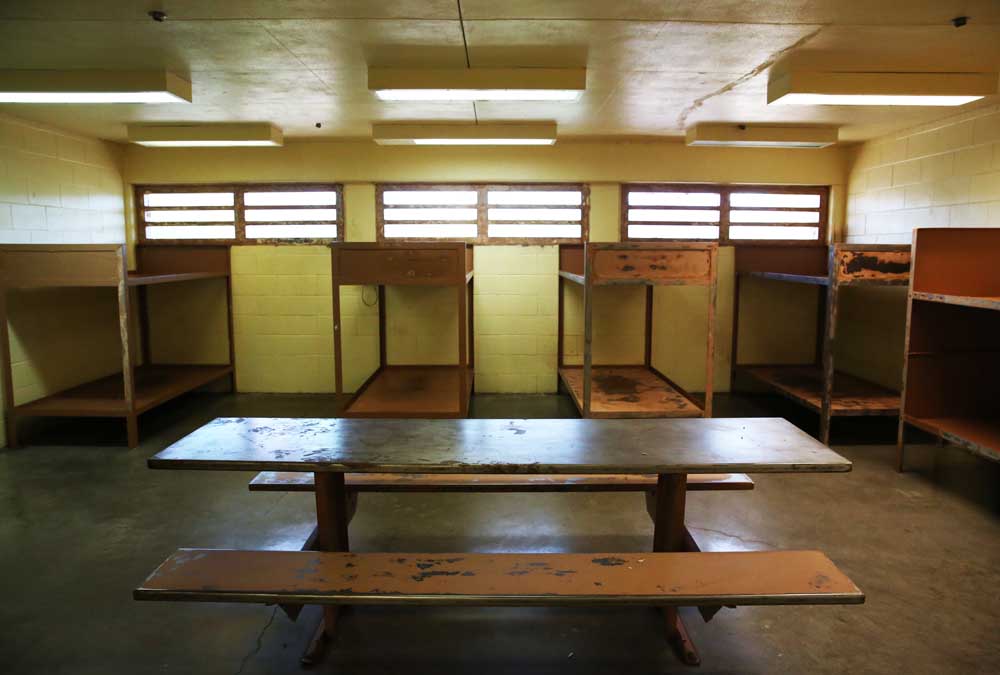Federal approval granted for new Warm Springs jail and police station
Published 1:30 am Wednesday, July 28, 2021

- A large men’s cell, commonly referred to as “the snake pit,” which has rusting beds that are coming detached from the walls, at the Warm Springs jail.
WARM SPRINGS — While putting together a recent funding request, Warm Springs Police Lt. Crystal Greene rounded up every unfulfilled maintenance order her department had filed with the federal government over the past 20 years.
Each form represents a different deficiency with the Warm Springs jail, built in 1987-1989, from a leaking roof to an unreliable power generator to a concrete wall that moves when pushed.
When she was done, Greene had filled a binder an inch and a half thick.
“The deterioration has been occurring for years,” Greene said. “All the maintenance work orders entered into the maintenance program at the (Bureau of Indian Affairs) have just been unaddressed, and this leads to the overall deterioration of the building.”
This month, the tribe received federal approval to build a new, modern public safety facility and is now planning a 60-bed detention center to be funded by the Bureau of Indian Affairs.
For Greene, who started at the department in 2006 and today oversees corrections, the news was a major relief.
“It’s exciting,” she said. “There’s a lot of work to be done, but it will be worth it at the end of the day.”
The jail has been effectively shut down since August, when the tribe determined it could no longer ensure the safety of inmates in light of COVID-19 protocols. On a number of occasions, an inmate would be booked into the jail and then jail staff would learn the person had been experiencing COVID-like symptoms. Since August, the department has transported most inmates to the Northern Oregon Regional Correctional Facilities in The Dalles.
Up until August, the jail was subject to an increasing number of major maintenance and design issues.
The common areas can’t accommodate more than 12 people at a time, which affects activities like church services and GED courses. The fire alarms issue false alarms nearly every day, the result of dirty sensors. And the poor ventilation was noticeable to jail staffers after leaving for the day, to say nothing of the inmates forcibly housed there.
“You can absolutely feel the difference when you leave,” Greene said.
The security monitors in the officer work station went down several years ago, and Evolve, the company that maintained them on behalf of the federal government, is no longer in business.
This means corrections officers must rely on first-person supervision only.
“You don’t ever want to ever rely on the cameras,” Greene said. “You have to be very in tune to your senses. You get to know what it sounds like when somebody punches a wall, or when someone’s head hits a wall.”
A number of tribal-owned buildings in Warm Springs are more modern than the police station, but they are tribal-owned, like the administrative office on Veterans Street. The police station, on the other hand, is the property of the federal government.
Bill Elliott, chief of the Warm Springs Tribal Police Department, compared the process of upgrading the police station to a renter convincing a landlord to make much-needed improvement to the rental property.
“The difference is, in the county, they can float a bond to build a jail,” Elliott said. “But we’re dealing with a totally different entity. We have to go to the federal government to build a jail.”
Elliott, 66, is a retired federal agent, Army vet and an enrolled member of the Kiowa tribe who keeps a residence near Kah-Nee-Tah. He took over as police chief around March 2020 at the request of the former Warm Springs public safety director, whom he knew.
On a recent Thursday, Elliott was to meet with members of the tribal council to discuss three potential sites. The council has indicated it prefers a site with utility hookups already in place and with enough space for possible future expansions, Elliott said. The layout of the new facility will be discussed once a location is chosen.
The small department operates under a complex array of three levels of government
The department lost a lot of staff during the pandemic, and after the jail closed in August, most corrections officers transferred to patrol.
“People have a misconception about the reservation,” Elliott said. “It’s no different than anyplace else. Since COVID hit, there hasn’t been a spike of criminal activity.”
Warm Springs has had to deal with the deadly drug fentanyl, like most rural communities in the West, Elliott said. But the problems that exist on the reservation are often overlooked because individually, they’re often too minor to warrant federal involvement.
“We’re never going to have 100 kilos of coke turn up, but what gets us are those low levels of drugs, and that’s no different than any other community out here,” Elliott said. “In a rural community, we die a death by a thousand cuts.”





